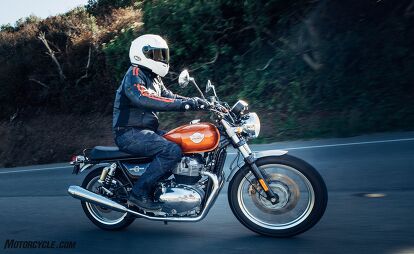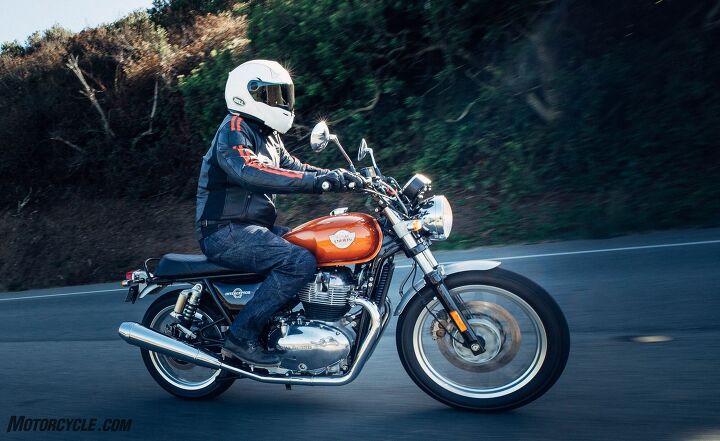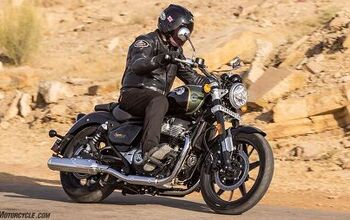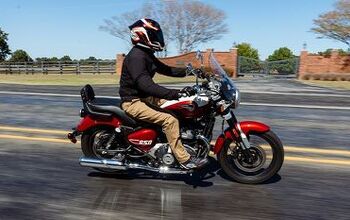2019 Royal Enfield Continental GT 650 And Interceptor 650 Review - First Ride

One platform; two personalities
Ever since my interview last December with Rod Copes, President of Royal Enfield North America, I’ve been looking forward to experiencing the new 650 Twin the company developed for the Continental GT 650 and the Interceptor 650. The common engine and chassis underlying these two models represent just one of “several” platforms slated to be released by RE in the next 3-5 years, according to Copes. Additionally, Copes claims that these platforms will all be aimed at the 400-700cc category because Royal Enfield wants to be the global leader in the middle-weight segment, which he thinks is underutilized as most manufacturers have been exploiting the heavy-weight market with its wider profit margins. Since I am a fan of both middle-weights and parallel Twins, these were heady statements to receive.
2019 Royal Enfield Continental GT 650
| Engine | 17.0/20 |
| Suspension/Handling | 12.5/15 |
| Transmission/Clutch | 8.75/10 |
| Brakes | 8.0/10 |
| Instruments/Controls | 3.5/5 |
| Ergonomics/Comfort | 8.5/10 |
| Appearance/Quality | 9.0/10 |
| Desirability | 9.0/10 |
| Value | 9.25/10 |
| Overall Score | 85.5/100 |
Interview: Rod Copes, President Of Royal Enfield North America
With those thoughts in mind, I arrived in Santa Cruz, California where Royal Enfield had gathered over 100 members of the international moto-press for two days of riding the Continental GT 650 and Interceptor 650. Would the 650 Twin be enough to propel Royal Enfield out of the niche it’s occupied in the U.S. with its funky small displacement Singles? The Himalayan has certainly turned heads in recent months and has proved popular with the MO staff. I could hardly wait to get in the saddles.
The 650 Twin
While Royal Enfield’s 650 Twin May look dated, it’s a decidedly modern unit – even with the air/oil-cooling. Every facet of the engine’s character was considered during the development. For example, three mule engines were built early on so that the type of crankshaft could be considered. Development riders and RE officials were able to ride bikes with a 180-, 270-, and 360-degree cranks back-to-back to directly judge which achieved the proper character and sound they desired. In the end, a 270-degree crankshaft was settled upon.
A pair of pistons with a 78mm x 67.8mm bore and stroke brings the actual displacement to 648cc and breathes through a four-valve head. Each of the rocker arms in the SOHC head features a rolling follower to relay the valve timing to two valves via a pair of fingers. Adjustment is via screw and locknut for easy maintenance. Inside the cylinders, the compression ratio is kept to a relatively tame 9.5:1. Finally, the twin pistons have their inherent vibrations quelled by a gear-driven counter-balancer.
Although the counterbalanced 411cc Single in the Himalayan should have prepared me for the first time I eased out the 650’s clutch and pulled into traffic, I was still shocked at how smooth the new engine was. It’s hard to shake the impression left by the older 535 Singles. Nevertheless, the 650 is quite smooth. In fact, vibrations don’t make their way into the pegs until the tachometer hits 5,500 rpm or the grips at about 6,200 rpm. The vibrations never become objectionable even when he engine is about to tap its 7,500 rpm redline. But I’m getting ahead of myself.
Negotiating what passes for traffic in Santa Cruz, the RE’s engine purred along, giving a delightful burble from its dual exhausts. The engine’s torque even allowed me to pull along at about 1,500 rpm without downshifting when I felt lazy in the slow-moving traffic. Between 2,000 and 2,500 rpm, 80% of the engines claimed 38.4 lb-ft of torque are available. The slip assist clutch is remarkably easy to modulate, and I appreciate the non-adjustable lever’s ease of use. For example, at one point during the second day’s ride, we got stuck behind a truck painting lines on a narrow two-lane road. For almost 15 minutes, we crept along in first gear at approximately 5 mph, working the friction zone the entire time. The slip assist clutch saved the day! Commuters will thank Royal Enfield for including it.
When it came time to shift gears, the cogs change smoothly, though maybe not as buttery as the best Japanese models. However, I never missed a shift, even when banging clutchless upshifts.
The fuel metering from the dual throttle bodies is spot on. No matter the rpm or whether the engine is accelerating or decelerating, the throttle transitions are silky-smooth. I can’t emphasize what a pleasure this engine is to sweep up and down through the rpm range. As the speed increases and the wind noise begins to drown out the exhaust note, a cool mechanical whine from the engine’s primary begins to fill the rider’s ears. Sweet. This is one fun engine.
Yes, the 650 Twin only makes a claimed 47 hp, so larger engines could rip its lungs out. However, that’s not the point of this Twin. Like the larger-displaced Ducati Scrambler, the Royal Enfield’s Twin is about elemental motorcycling or just plain fun. You can burble along enjoying the view and unintimidating power, or you can crouch down and wring the rpms out, enjoying the pleasures of riding a slow bike fast.
The chassis
A steel backbone frame with dual cradles support the engine. The rake is a reasonably sporty 24°. Up front, a 41 mm, non-adjustable traditional fork negates the bumps while, out back, dual, preload adjustable, coil-over reservoir shocks control the rear wheel. Wheel travel is 4.5 inches and 3.5 inches front and rear, respectively. The wheels themselves are 18-inch spoked items with bespoke tubed Pirelli Phantom Sportscomp RS tires.
2019 Royal Enfield Interceptor 650
| Engine | 17.0/20 |
| Suspension/Handling | 12.5/15 |
| Transmission/Clutch | 8.75/10 |
| Brakes | 8.0/10 |
| Instruments/Controls | 3.5/5 |
| Ergonomics/Comfort | 9.0/10 |
| Appearance/Quality | 9.0/10 |
| Desirability | 9.0/10 |
| Value | 9.25/10 |
| Overall Score | 86/100 |
On the road at moderate speeds, the suspenders are in their happy place, gobbling up road irregularities. As the pace increases, however, their ability to cope with bumps gets tested. Overall, the suspenders are able to handle the initial impact quite well. It’s the rebound that poses the problem.
The Royal Enfield’s boingy ride is clearly contributed to by the lack of rebound in the fork. I’m less clear about what is going on in the rear. In a late night discussion with another journalist that had us outside the hotel bouncing an Interceptor on its suspension, he attempted to convince me that the back end was actually packing (i. e. not extending quickly enough from bump to bump, resulting in less available suspension travel). While the suspension forces we were able to generate by hand did have the back of the bike uncompressing much slower than the front, the sensations I’ve gotten from the seat told me that, after high-speed compression, the back rebounds too quickly. Clearly, I need to get some more seat time on this bike to be sure. However, I feel that the fact that I’m having this internal debate at all points to how well the suspension on the Royal Enfield Twins works for bikes in this price range.
With 18-inch wheels front and rear, I was prepared for potentially staid steering dynamics. I was wrong. The leverage provided by the Interceptor’s wide bar and the GT’s clip-ons allowed me to bend the bikes into a series of tight corners with surprising alacrity. While not the snap of a hyper-sports bike, it still provides the sure-footedness of a sporty standard. Our route ran the gamut from high-speed sweepers to tight-n-twisty first- and second-gear corners, so I was able to test the bikes in a good variety of conditions. (I hear we passed some amazing scenery out in the rolling hills and through the maze of redwoods, but I was too enthralled with the ride to notice.)
Aside from the excessive rebound I’ve already discussed, the only handling issue I noticed is an occasional tendency to wobble at high speeds. On both the Interceptor and the GT, this wobble briefly appears in the space between peak braking force and the turn in point of a corner. Once the bikes are banked over in the corner it tracks true. Additionally, on the Interceptor, I also experienced the wobble under acceleration when cresting a hill a high speed, lightening the front wheel. I believe the Interceptor’s more upright riding position puts slightly less weight on he front wheel, making it more prone to the wobble. Regardless, the wobble occurs at times when the front suspension is uncompressing, so I think the symptom is related to the excessive fork rebound. While both bikes never do anything wrong, the wobble is unsettling the first few times it happens. I think it is just the bikes’ way of letting me know I was exceeding their happy place.
I want to compliment Royal Enfield on its selection of the testing routes for the Interceptor and the Continental GT. Where some manufacturers might select roads with only the smoothest pavement in order to mask any shortcomings of their motorcycle, my two days of riding covered the full gamut of surfaces from billiard table smooth to bumpy tight corners and everything in between. Clearly, Royal Enfield was confident in their 650 Twins’ capabilities.
Interceptor 650
While the chassis is exactly the same for the Twins, some particulars make the Interceptor unique. First, the handlebar places the rider in a comfortable upright position. The pegs assist in this by placing the rider’s toes adjacent to the rear of the engine for an extremely comfortable rider triangle. Royal Enfield has given the bikes a retro styling that consistently plays across the motorcycle. The flat, couch-like seat offers plenty of room for two and looks like it would have been at home during the era of the Universal Japanese Motorcycle – and that’s exactly what inspired Royal Enfield.
The era that the Interceptor’s designers were inspired by comes from the years 1960-1970 in which the California youth lifestyle-inspired Interceptor 700 was manufactured. Although clearly a modernized vision of the 700, the Interceptor 650 feels true to its inspiration. When looking at the Interceptor 650, the resemblance is clear from the headlight to the chrome wheels to the fork gaiters to the seat shape and the dual shocks. Royal Enfield has created the right combination of modern and retro.
Continental GT 650
The difference between the riding position on the Interceptor and the Continental GT is pronounced but not radical. While the rider’s body is canted forward, the reach to the clip-ons is not uncomfortable. The angle actually helps the rider combat the wind blast of highway-speed riding. With the upper body inclined forward, the feet naturally move rearward, and to compensate for this, the pegs were relocated approximately 1.5 inches back.
If you look closely at the photo above, there are only two other changes between the two models to note. First, the gas tank is not the teardrop of the Interceptor but rather it is narrower with a higher back for a more cafe racer shape. This does come at a 0.3 gallon cost, making the GT’s capacity 3.3 gallons. The other change is the seat, which is shorter, flatter, thinner, and has a sporty hump. This, too, has a slight cost. In this case, the seat is firmer and its edges cut into my thighs as the miles racked up. Still, this is only a minor quibble that hasn’t kept me from requesting the Continental GT to use in a shootout.
The verdict
I’ll say again that I was surprised by the quality of the engine powering the Interceptor 650 and the Continental GT 650. Nothing, not even the Himalayan, had prepared me for the smoothness in terms of both vibration and EFI that I encountered during my two days of riding. Royal Enfield took aim at a hole in what it perceived that the major motorcycle manufacturers were offering to the worldwide markets and decided to deliver a product that could be sold unaltered in every market. What this means is that the same motorcycle is both EPA and Euro-5 compliant, as well as legal in many other countries, which lessens the cost of manufacturing and distribution.
The other goal for the 650 Twins was to price them competitively. Last year, Copes told me that they hoped to get them in for under $7,000. I don’t think that even the most optimistic of us could’ve anticipated that the base price for the Continental GT would be a mere $5,999 or that the Interceptor 650 would be priced even lower at a $5,799 base price. In addition to the low price, RE is offering a three year warranty on the 650 Twins, complete with roadside assistance.
Join other Royal Enfield fans at the Royal Enfield Forum!
And that’s not all. Minutes after announcing the U.S. Interceptor and Continental GT pricing in a worldwide livestream, Copes sat down with the North American journalists and stated that in the next 3-5 years, Royal Enfield would be introducing 2-3 new middleweight platforms (engine and chassis pairings) that would result in a total of 12 new motorcycles from the company – all ranging in price from $4,000-$8,000. Based on what we’ve seen in recent years from the company, I believe it. Royal Enfield has gone from producing 50,000 motorcycles in 2010 to an anticipated 950,000 in 2018. The company clearly wants to play an increasing role on the global motorcycle stage, growing its presence in the more mature markets, like the U.S. where it is actively expanding its dealer network. If the Continental GT and the Interceptor are examples of what is to come, we can’t wait to see what is next.
2019 Royal Enfield Continental GT 650
+ Highs
- Smooth engine with broad power spread
- Cafe riding position increases sporty feel
- A lot of motorcycle for the price
– Sighs
- Suspension defines the limits of backroads shenanigans
- Slight front end wobble on corner entry
- Hard-edged touring saddle
2019 Royal Enfield Interceptor 650
+ Highs
- Smooth engine with broad power spread
- Upright body position for relaxed riding
- Surprising fit and finish for the price
– Sighs
- Excessive rebound from suspension
- Slightly more frequent front end wobble
- Brakes could be stronger
In Gear

Helmet: Bell SRT-M $350
- Jacket: Alpinestars Oscar Charlie Tech-Air Compatible $650
- Airbag: Tech-Air Race Airbag System $1,150
- Pants: Alpinestars Riffs $300
- Boots: Rev’It Regent H2O Boots $350
Gloves: Reax Castor Sport Leather Gloves $89
| Royal Enfield | Continental GT 650 | Interceptor 650 |
|---|---|---|
| MSRP | $5,999, $6,249 (Custom), $6,749 (Chrome) | $5,799, $5,999 (Custom), $6,499 (Chrome) |
| Engine Type | 4 stroke, air-oil cooled, 648cc parallel twin | |
| Bore and Stroke | 78mm x 67.8mm | |
| Fuel System | EFI | |
| Compression Ratio | 9.5:1 | |
| Valve Train | SOHC, 4 valves per cylinder | |
| Transmission | 6-speed | |
| Final Drive | Chain | |
| Front Suspension | 41mm fork, 4.5-in travel | |
| Rear Suspension | Twin, coil-over shocks, 3.5-in travel | |
| Front Brake | 320mm disc; 2-piston, single action-caliper; ABS | |
| Rear Brake | 240mm disc, single-action caliper, ABS | |
| Front Tire | 100/90-18 | |
| Rear Tire | 130/70-18 | |
| Rake/Trail | 24°/NA | |
| Wheelbase | 55.1 in. | |
| Seat Height | 31.1 in. | 31.6 in. |
| Curb Weight | 435 lb (claimed, dry) | 444 lb (claimed, dry) |
| Fuel Capacity | 3.3 gal. | 3.6 gal. |
| Available Colors | Black Magic, Ventura Blue, Mister Clean, Dr. Mayem, Ice Queen | Mark III, Glitter & Dust, Orange Crush, Ravishing Red, Silver Spectre, Baker Express |

Like most of the best happenings in his life, Evans stumbled into his motojournalism career. While on his way to a planned life in academia, he applied for a job at a motorcycle magazine, thinking he’d get the opportunity to write some freelance articles. Instead, he was offered a full-time job in which he discovered he could actually get paid to ride other people’s motorcycles – and he’s never looked back. Over the 25 years he’s been in the motorcycle industry, Evans has written two books, 101 Sportbike Performance Projects and How to Modify Your Metric Cruiser, and has ridden just about every production motorcycle manufactured. Evans has a deep love of motorcycles and believes they are a force for good in the world.
More by Evans Brasfield







































































Comments
Join the conversation
Excuse me, 9.25 for value? It's the bottom of the ninth game winning homer IMO. If anything is a 10 out of 10 this is it.
I've just spent 7 days riding the Interceptor down in Baja. While I can't speak to long term reliability I can tell you the apperance of the 650 reeks of quality. It really looks well made. Nothing on it is crude or sloppy.
The thing runs great. It's a free revving engine that doesn't sound like a 270 crank. More like a 180. The 650 is light on its feet and steers like buttah. Top speed was 115 indicated sitting upright. This bike is nothing like a plodding Bullet.
I'd buy one of I had money laying about.